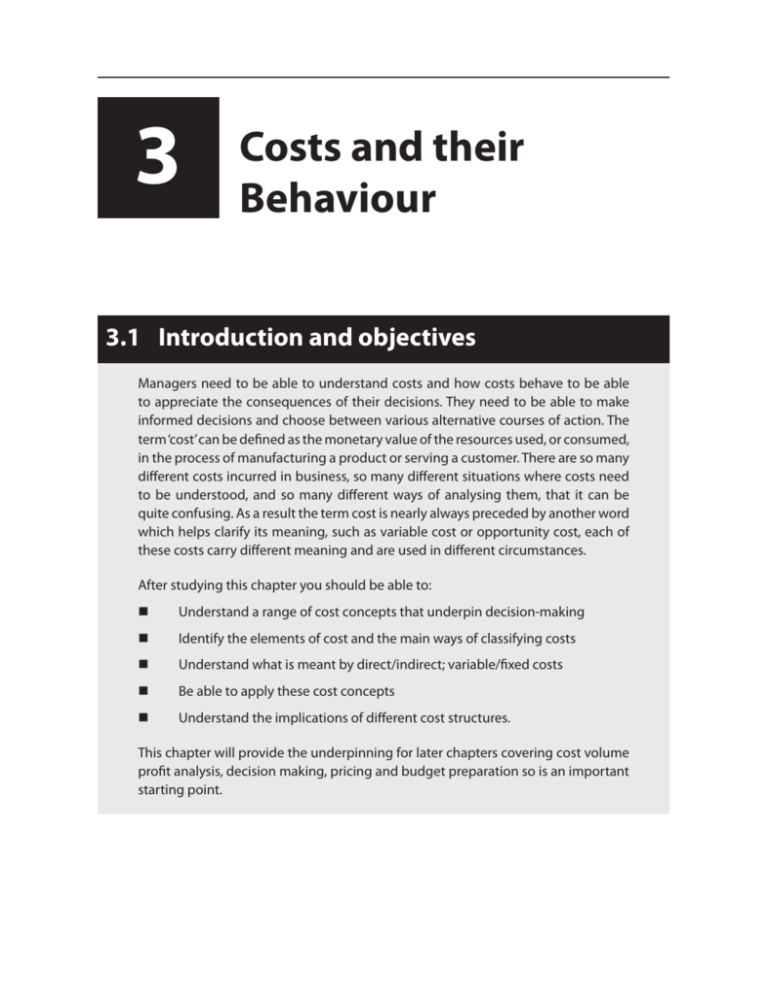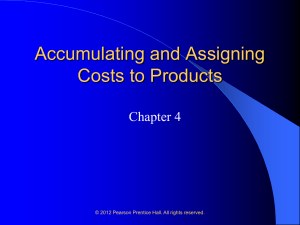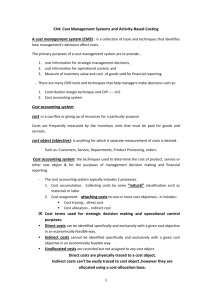Chapter 3 - Goodfellow Publishers
advertisement

3 Costs and their Behaviour 3.1 Introduction and objectives Managers need to be able to understand costs and how costs behave to be able to appreciate the consequences of their decisions. They need to be able to make informed decisions and choose between various alternative courses of action. The term ‘cost’ can be defined as the monetary value of the resources used, or consumed, in the process of manufacturing a product or serving a customer. There are so many different costs incurred in business, so many different situations where costs need to be understood, and so many different ways of analysing them, that it can be quite confusing. As a result the term cost is nearly always preceded by another word which helps clarify its meaning, such as variable cost or opportunity cost, each of these costs carry different meaning and are used in different circumstances. After studying this chapter you should be able to: Understand a range of cost concepts that underpin decision-making Identify the elements of cost and the main ways of classifying costs Understand what is meant by direct/indirect; variable/fixed costs Be able to apply these cost concepts Understand the implications of different cost structures. This chapter will provide the underpinning for later chapters covering cost volume profit analysis, decision making, pricing and budget preparation so is an important starting point. Costs and their Behaviour 29 3.2 Classifying costs It is important to recognise that there are different ways of classifying costs, Figure 3.1 provides a summary of the main ways of classifying costs, and these will be 29 and their Behaviour explained and discussed in more depth throughout Costs this chapter. Method of classification Basic elements Direct and indirect Fixed and variable cost Purpose Basic record keeping for income statement Relating costs to departments, services or products Expose relationship to volume Cost categories TOTAL COSTS Direct Materials MATERIALS LABOUR EXPENSES Direct Labour Direct Expenses Indirect Materials SEMI-VARIABLE COSTS Indirect Labour Indirect Expenses Application VARIABLE COSTS FIXED COSTS Internal and Absorption costing, cost control, Marginal costing, cost volume external reporting responsibility accounting, pricing, profit analysis, flexible of cost and profit activity based costing and budgeting, variance analysis, customer profitability analysis operational gearing, and pricing Figure 3.1: Three cost classifications This chapter considers how costs can be classified for use in management decision making. In later chapters, costs will be further analysed in relation to specific decision making such as short-term or long-term decisions. 3.2.1 Basic cost elements This represents the most fundamental form of classification. Here costs are identified in terms of the basic resources of materials, labour and expenses necessary to produce a product or service. Thus, in the case of a hotel, materials in the form of food are purchased and transformed to provide breakfast, labour is utilised to clean rooms and provide reception services and general expenses (including electricity, insurance, marketing) are amongst other vital inputs to the process of providing guests with a good night’s sleep. This method of grouping costs has been developed to provide useful information on the resources that are used in the production process and is considered as a convenient way of assembling costs for the presentation of profit statements (i.e. the income statement and other internal management reports). 3 3 30 Strategic Managerial Accounting 3.2.2 Direct/indirect costs The second method of classifying costs relates to whether they can be attributed or assigned to a specific product or service. This method of classification is used for management control purposes. Direct costs are those that can be directly identified with, or linked to, a particular product, department or saleable service and can sometimes be called traceable costs. Direct costs are further broken down into the three key elements creating direct materials, direct labour and direct expenses. Examples of direct costs for an event would be: Direct materials Food and beverages Tickets Direct labour Bar staff Artists’ fees Direct expenses Event licence Event insurance Indirect costs cannot be easily identified with a particular product, department or service. They can also be broken down further in the same way as direct costs. Examples of indirect costs for an event would be: Indirect materials Cleaning materials Indirect labour Event organiser’s annual salary Indirect expenses Vehicle running costs Head office heating and lighting Generally within the hospitality, tourism and events industries there are numerous costs that fall into the indirect category, however there are exceptions and variations, an example of a direct expense, which may be considered indirect normally, is rent, in this case, the one-­off rental by a hotel of audio-visual equipment for a specific conference would be a direct cost of that conference. It therefore becomes apparent that the classification of costs into direct and indirect groups is dependent on the context and/or the type and scale of the business activity. Look at the examples below to see how costs can be categorised in different circumstances. Table 3.1: Cost classification in business context Cost Context Classification Food Restaurant Direct – food cost of meals sold to customers Indirect – food cost of meals provided for staff Fuel costs Airlines Direct – fuelling a plane Indirect – fuelling ground vehicles Energy Hotel Direct – metered gas in kitchens Indirect – general lighting of public areas Marketing and advertising Event Direct – advertising specific one-off event Indirect – company promotion at wedding fair







